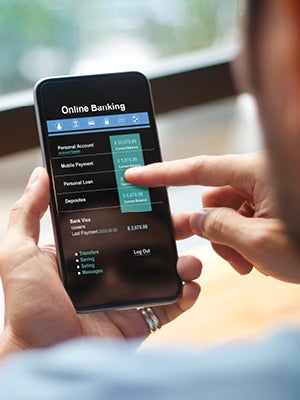Learn More About Direct Deposit
It’s easy to take conveniences like direct deposit for granted without fully understanding how it works or why you should use it. You may have questions concerning direct deposit, so we want to make sure you fully understand the system.
 How Does Direct Deposit Work?
How Does Direct Deposit Work?
Direct deposit forgoes the physical printing of payment checks by transferring money online through software like payroll programs. An electronic file is transmitted to or from your financial institution, which lets the recipient know which account should receive payment/deduction and how much.
Financial institutions connect to each other and move payments via the Automated Clearing House network. When you receive funds via a direct deposit, your account balance will automatically increase when the payment arrives. So instead of waiting 2-5 business days for a paper check deposit to clear, you often have access to these funds on the same day they’re sent into your account. All you need to set up a direct deposit is your financial institution’s routing number, your account number, the type of account being deposited into or debited and the amount to transfer. All of that can be found on a blank personal check of yours.
Is Direct Deposit Safe?
In the past, paper checks and ATM deposits seemed like the most secure way to receive and make payments. Your visibility of and involvement in the transfer of money from one financial institution to another by carrying and submitting the paper check made you feel in control. But, that assurance is false; it’s actually less secure to carry and deposit a paper check. Direct deposit is generally safer than being paid via check because paper checks can be lost or stolen, and it’s possible for someone to fraudulently cash a check not made out to them. Since a direct deposit transfers automatically from the payer’s account to your account, it cannot be lost or stolen. Direct deposit is so reliable that the U.S. government has used it for Social Security payments for decades, and per its records “since 1976 when Direct Deposit first became available to Social Security beneficiaries, not one payment has ever been lost.”
Why Should I Use Direct Deposit?
The most obvious benefit of using direct deposit is avoiding the possibility of losing a paper check. This also is eco-friendly, saving the financier wasted time and resources involved with using paper. When it comes to receiving your wages from your employer, direct deposit allows you to divide your earnings so they’re sent to more than one account. If you want to split your paycheck between multiple accounts you can add each account to the direct deposit form and specify how much of your pay should go into each.
Is Direct Deposit For More Than Just Payroll?
Many people rely on a direct deposit to receive their recurring employment paychecks, but there are many others ways that you can use this payment system. There are a handful of these, including Social Security benefits, disability compensation for veterans, tax refunds and disbursement of insurance benefits.
Direct deposit makes receiving and sending money much easier, quicker and more secure. Make sure you’re taking advantage of direct deposit in your daily finances; it offers a lot of benefits and is simple to set up.
Pros and Cons of Automatic Payments
Setting up regular withdrawals for your bills and subscriptions can make life significantly more convenient, but it can also come with some downsides.
First Bank & Trust, a division of HTLF Bank Mobile App
Download the app to view balances, transfer funds, deposit checks, pay bills, and more.









